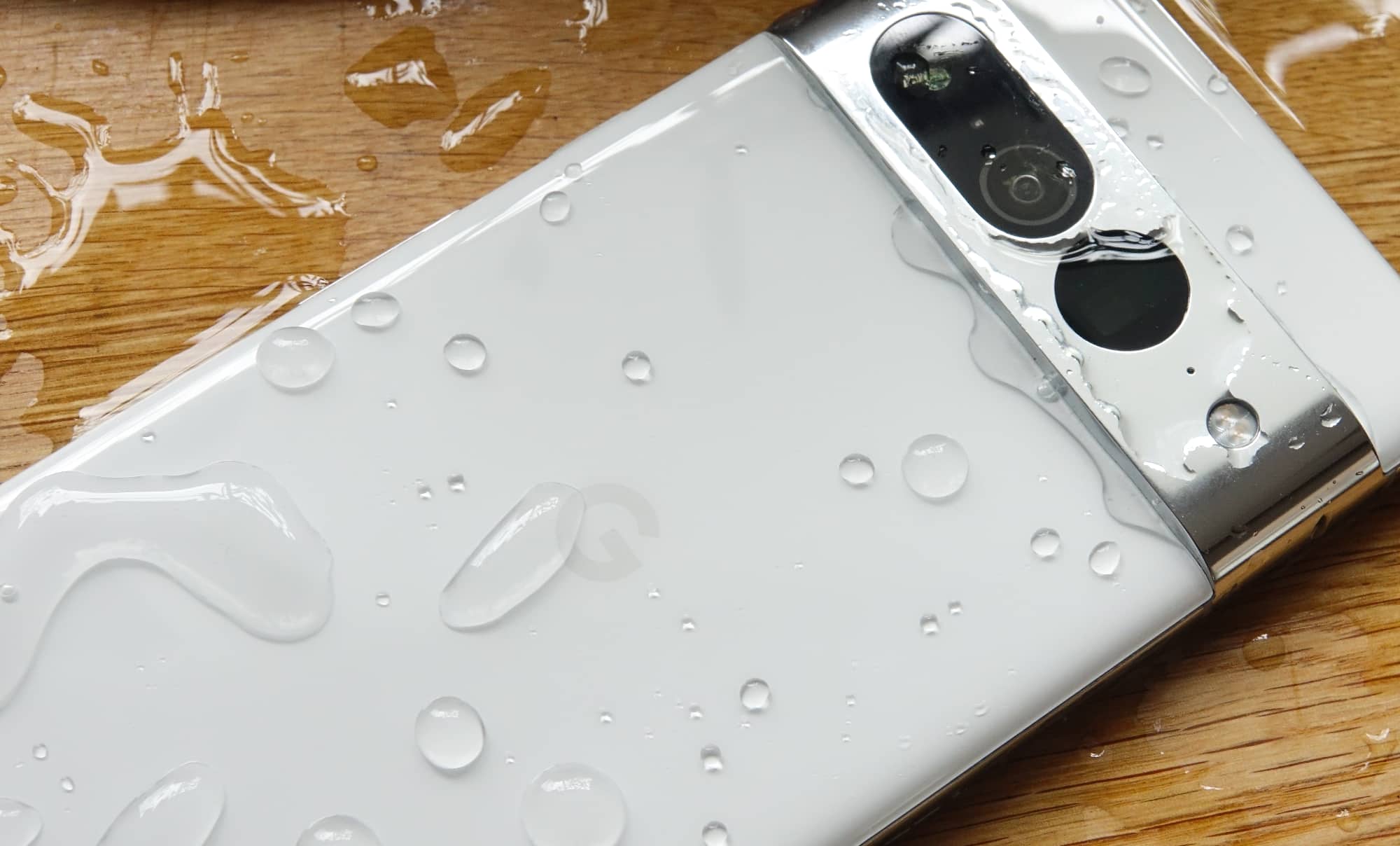Quick review
The good
The not-so-good
Armed with three cameras, two types of 5G, and a premium look and feel, the Google Pixel 7 Pro could well be the closest we’ve seen to “value” in flagship phones.
Design
It’s 2022, and while Google has a new phone for you to play with, glancing at the front and sides of the phone, you’d never realise anything had changed.
A slightly evolved take on the Pixel 6 Pro is what the Pixel 7 Pro has going for it in design, with the top edge and back the only major points of difference. The plastic covered top is now a shiny metal surface on the new model, while the back sees a slightly shinier and seemingly thicker bar for the camera system.
Outside of this, however, the phones look largely the same, with a glass front and back, the slightly thick bar for the camera, and a design that’s easy on the eyes.
Worth noting is that while the glass front and back might make the phone premium, the lack of a texture also means the Pixel 7 Pro can be really slippery. Keep a hold of this one, because like other slick glass mobiles, if you don’t sheathe it with a case, it can feel like it’ll fall from your hands quite quickly and all too easily.
Features
Under this glass body is a smattering of specs deserved of the word “flagship”, even if the price might be under what typically designates flagship phones today.
For the $1299 price in Australia, you’ll find the 128GB Pixel 7 Pro, though other storage options come in at 256GB ($1449) and 512GB ($1599), with the same hardware underneath all.
Every version of the Pixel 7 Pro is powered by Google’s Tensor G2 chip, the second generation of the machine learning connected processor first found in the Pixel 6 range, working with 12GB RAM and Android 13 out of the box.
They all feature a three camera setup on the back, comprised of a 50 megapixel F1.85 wide camera (1X), a 12 megapixel F2.2 ultra-wide (0.5X), and a 48 megapixel F3.5 5X zoom camera, with the hardware also able to blend the difference between the ranges by downscaling the images back to 12 megapixels and cropping through the sensor to account for zoom. The idea is a little like what Leica does for its Q cameras, whereby a big sensor at one focal length is cut down to lower megapixel amounts and closer range zoom by effectively cropping the sensor.
That camera system will also support a macro mode and portrait shots where the background is out of focus, and it can handle up to 4K video, as well, with a few extra modes thrown in for good measure.
There’s a 4K timelapse mode, an astrophotographers timelapse video mode, HDR video, slow-motion at up to 240 frames per second, and a recent addition of a “cinematic” mode that can keep the video either stable when being panned (camera moving from left to right) or blurring the background of a person’s face, almost like portrait video mode.
At the front, the camera system is less complex, opting for a 10.8 megapixel F2.2 camera with a fixed focus.
Wireless connections for the Pixel 7 Pro are fairly plentiful, and it could be the most complex assortment of wireless options on a phone in Australia, covering 802.11a/b/g/n/ac/ax WiFi 6E, Bluetooth 5.2, Near-Field Communication (NFC) for Google Pay, GPS, ultra-wideband, and 5G over both the common sub-6 technology plus the less common mmWave stuff (less common in Australia, anyway). A year after mmWave 5G launched in Australia on the Pixel 6 Pro, the Pixel 7 Pro is the second phone to support it locally.
Wired connections are markedly less plentiful, with just one to speak of: a Type C USB port at the very base of the phone.
You can use that Type C port for data or charging, but you can also use Qi wireless charging to breathe battery life back into the Pixel 7 Pro if you need to.
And it all sits under a 6.7 inch QHD+ 3120×1440 OLED screen, providing a pixel clarity of 512 pixels per inch, and protected by Corning’s Gorilla Glass Victus. An always-on display mode is part of the design, but with text and other information shown on a black screen, and a fingerprint sensor is built into that display, as well.
There’s also support for automatic translation in the voice recorder app, automatic cloning via magic eraser in the photos app, and eventually a VPN as part of the Google One program, though that may not pop up until later in the year.
Beyond this, the Pixel 7 Pro comes with IP68 water and dust resistance, and a 5000mAh battery.
In-use
Out of the box and ready for action, the Pixel 7 Pro arrives with Google’s latest operating system ready, Android 13, and it’s a pretty nice and stock affair. Oppo may have ColorOS and Samsung One UI, but Google’s clear approach with nothing extra is still something we love, and simple to use once you get the hang of it.
Offering gestures not unlike what you can use on the iPhone, a swipe up from the top to bottom will bring you home, a shorter swipe from the bottom to the middle gets you multitasking, and back and forth left and right gestures get you forward and backward. Rinse, repeat, it’s all the same.
Logging into the phone is handled by one of two methods, offering you the fingerprint sensor in the screen or a facial security. We found the latter often kicked in before the former, but you have options, and that means if the facial security doesn’t work for you, maybe because you’re wearing a mask, you can still unlock without a PIN by pressing your thumb to the screen.
We’d prefer the traditional fingerprint scanner on an actual physical element, like the power button on some devices or a button on the back of a phone (like in the Pixel 5), but this is acceptable all the same.
Performance
Regardless of how you log into the phone, you should find a super snappy performance waiting for you ready to be used.
While we haven’t been able to push the Tensor G1 chip significantly, the Tensor G2 seems just as solid overall, and offers little to no lag as you jump from app to app, likely helped by that decent amount of memory, all 12GB of it.
Frustratingly, the app we use to benchmark — Geekbench — is unavailable on the phones with the Tensor chip, meaning no graphs like we normally have. That may not matter to you, but it does mean comparative performance hasn’t been able to be gauged in this Pixel 7 Pro review.
If comparative performance isn’t a big deal, know that what we experienced showed the phone to be snappy, though our 5G experience was hit and miss, possibly because of our provider.
Tested in Sydney on the Telstra 5G network, we found our speeds invariably topped out at 150Mbps, which is fine, but hasn’t flexed the capability of the mmWave technology at all. As with all 5G tests, your mileage may vary (and probably will), but given that this phone has all the 5G technologies on the horizon, you should get decent performance on the mobile side of things, too.
Camera
Possibly the standout part of the Pixel 7 Pro experience is the camera, a clear focus given it takes up a physical element of the phone design stretched across the back.
Like what you can find on the iPhone 14 Pro, there’s a combination of three cameras in this phone, running the gauntlet of wide, ultra-wide, and telephoto. Unlike Apple’s competitor, the telephoto stretches the sensor size and focal length, with a lot of room on each.
As such, you’ll find a 1X wide camera using the 50 megapixel sensor from last year, a 12 megapixel 0.5X ultra-wide, and a 48 megapixel camera covering the 5X telephoto range, with some neat software and algorithmic stuff on the inside bridging the gap between focal lengths. Jumping from 1X to 5X isn’t realistic, so Google is splitting the difference between these lengths by using the sensors and cropping, while zoom ranges before 5X use digital zoom and algorithms to blow up the images and sharpen the result.
It’s a combination that can work well, and gives you a decent amount of versatility in a phone camera, even if 5X doesn’t actually end up seeming like a lot.
Regardless of what you capture, the Pixel 7 Pro camera system will cut those big sensor sizes down to 12 megapixels, with nice results through it all. In daylight, images work beautifully, often with crisp images and lovely colour, while night-time shots can deliver lovely results, as well.
Snap a picture straight up at the sky at night and you’ll turn into an impromptu astrophotographer, with one of the nicer long exposure modes that just works, and it’s a similar result for portrait shots, too.
Like other mobile cameras, the Pixel 7 Pro camera system is able to give you an out of focus background for portraits if you want it to, keeping the foreground sharp while the back goes all soft and creamy. It’s a process that takes a second or two after capture, and delivers results that just pop.
In fact, the portrait shots are so good, Google may actually have beaten Apple in one area on cameras, because almost every portrait shot is a winner. It’s just that solid a mode.
There’s also support for macro shots when you’re close, and the results can be nice, though at times feel over-sharpened. It’s a good beginning, though, and one that’ll likely improve over time with subsequent updates.
Battery
On the downside, there’s the battery, which doesn’t fare as well as we’d hoped, getting roughly the same as it did last year, but no major improvements anywhere. You might even get a little less.
Armed with a 5000 mAh battery, we found 24 hours was possible maxing out closer to 30, but anything over that would be pushing it, with the large-ish battery not quite delivering on what big phones often do.
Repeated testing found the Pixel 7 Pro could hit roughly 5 hours of screen time as a maximum, which is nice, but not where we expect big phones to land, missing out on the crucial extra hour to hour and a half you might yearn for.
Value
One area that scores a solid win is the price, which just nails value especially well.
In an era where mobile makers are moving the needle on smartphone pricing in a significant way, and releasing the premium phones with especially high price tags, the Pixel 7 Pro is downright affordable when compared against its peers.
In Australia, the Google Pixel 7 Pro will cost you $1299 outright, lower than other big flagship phones, including the $1849 price of the 128GB Samsung Galaxy S22 Ultra and the $1899 price for the 128GB Apple iPhone 14 Pro Max. Both are big phones it technically competes with, and Google wins on value easily, delivering best-in-class specs and cameras, but with a much, much lower price.
Certainly, $600 is nothing to sneeze at, and Google is clearly going for the price argument in this phone.
What needs work?
But it’s not entirely perfect, and between the slippery design and not-super-impressive battery life, we have concerns. Google nails the value, but there are quibbles, and some are on that camera.
As much as we love the camera, there are areas Google could improve things, particularly with what it’s competing with.
Take the Cinematic Mode, which only works on the one standard wide camera at the back, compared to how Apple has it working on two plus the front camera. It feels very much like Google’s addition of this technology is competing in a first-generation kind of way, compared to the second we’re seeing Apple fight in.
It’s a similar issue in regards to clarity through the camera system, because while the idea of the camera able to go through the motions of 0.5X to 5X, plus use some digital enhancements to hit 10X and higher is nice, it doesn’t always work out to be super clear.
Some shots will struggle for clarity as the sensor jumps between its natural state of 1X and 5X, using cropping of the sensors to change what’s being shown and not always nailing it. Images will vary, but it’s not as perfect as the marketing materials might make it out to be. We’re sure you’re shocked.
There’s also another factor worth talking about, and that’s long term support. Simply put, Google is only guaranteeing Android version updates for three years, with the Pixel 7 Pro and its smaller Pixel 7 sibling tapping out in October 2025. You’ll continue to get security updates until October 2027, but Android versions will finish in three years time, meaning it will likely see Android 14 in 2023, Android 15 in 2024, and Android 16 in 2025.
That’s in stark comparison to how far back Apple goes, with the iPhone 8, iPhone 8 Plus, and iPhone X all supporting the latest version of iOS, iOS 16, even though those phones are five years old.
Apple is supporting phones with five years of operating system updates, while Google is maxing out at three. Even though phone upgrades are normal around the three year mark, they don’t have to be, and we’d call that a less than impressive approach from Google, to say the least.
Final thoughts (TLDR)
Even with the odd niggle, there are great reasons to consider the Pixel 7 Pro.
It’s a premium device inside and out, and it not only looks great, but is solid, too. For the most part, the camera system does some great things, and while it doesn’t entirely live up to the competition, the combination of features for the price makes the Pixel 7 Pro worth looking into.
Owners of the Pixel 6 Pro won’t see an upgrade path here, but if you love the Android experience and want the best value Android all year, this is it. The Pixel 7 Pro is not only the best value Android, but Android’s best this year. Recommended.














